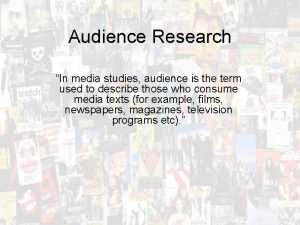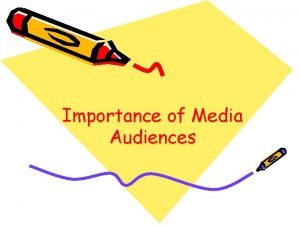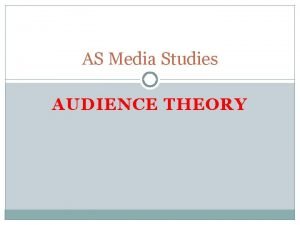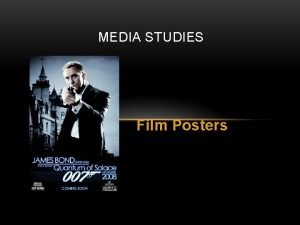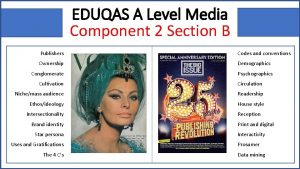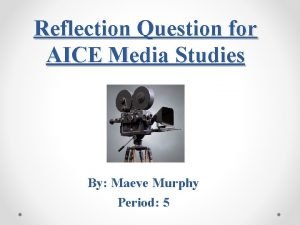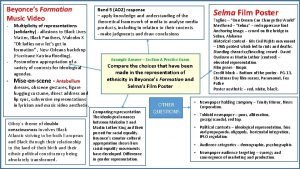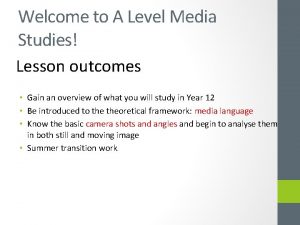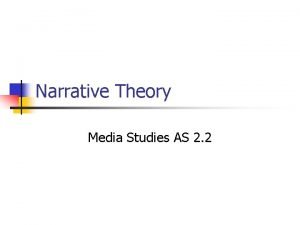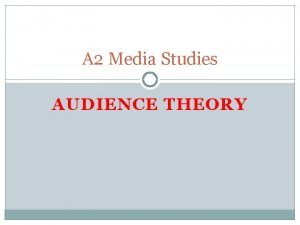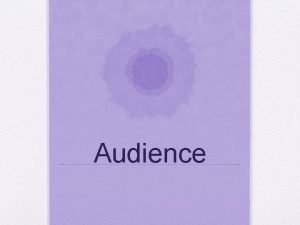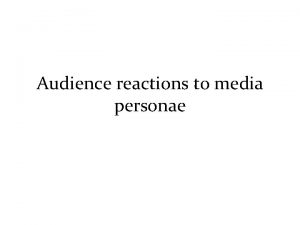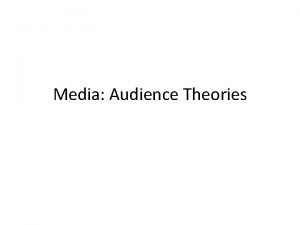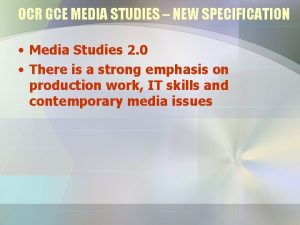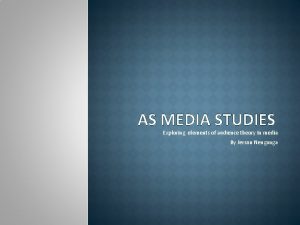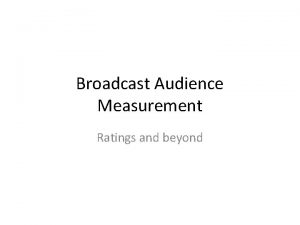Media Studies Unit 1 Lesson 14 Audience Lesson


























- Slides: 26

Media Studies Unit 1 Lesson 14 Audience

Lesson Objective • At the end of this lesson we will have studied how audiences are targeted.

Consider the following film poster. Which audiences do you think are being targeted?

Consider the following film poster. Which audiences do you think are being targeted?

Consider the following film posters. Which audiences do you think are being targeted?

Consider the following film poster. Which audiences do you think are being targeted?

Film Posters • Posters communicate information by the way the images are presented. • The gesture codes (facial expression or body language) of the characters instantly signal violent and disturbing events or romantic and comic moments. • Details like costume, location and lighting also help us read the poster’s message.

Film Posters • The tag line: a short, catchy statement on a film poster suggesting the film’s content. • Genre is a key message that posters try to get across. This is often reinforced with the tag line. For example…

In space no one can hear you scream.

Task • Write a tag line for each of the following films: 1) First Victim: a young vampire hits a suburban town looking for his first victim. 2) No Way, Baby: 16 year old heart-throb Jay says he’ll never be in a steady relationship – the girls decide to test him 3) Triple Deceit: Detective Dean is baffled by a series of murders until his new partner gives him some valuable insight. But where is the new information coming from?

Promoting Stars • One way a poster grabs people’s attention is by showing pictures of the film’s stars. The more popular the star, the more dominant their image will be. • Stars are said to be A list or B list, depending on their ‘box office draw’ (whether or not they are deemed popular enough to make a film successful, based on their appearance alone).

Who is the box office draw for the following films…





Film Posters • The size and position of a star’s name and image are so important that they are part of the star’s contract for the film. • Big stars try to get their name on the left of the poster and their picture on the right, because these are the most eye catching positions.

• Who has these positions in this poster?

Targeting audience • Film posters target audiences, and audiences vary around the world. • Posters therefore change, depending on which country they are being released in. Consider the posters on the following slide…


City of God • What does each poster suggest to you about the film? • What is the target audience of each poster? • Why do you suppose they are so different?

Trailers • Designed to give audiences a taste of the film. They are meant to have maximum impact. • Films trailed in cinema are often the same genre as the main feature, targeting the audience more precisely – they offer the audience something similar to what they have already paid to watch.

• Unlike TV trailers, cinema trailers have a captive audience (people who are unlikely to stop consuming a media text).

• Trailers are made by specialist companies. They have certain common features in order to convey in a couple of minutes a message that people will remember.

Trailer Codes • Show the best bits of the film. • Action codes – use one action to indicate what is going to happen: a character is seen taking a suitcase down, so the audience knows they are going on a journey. • Enigma codes – set the scene while giving very little away: a hand is seen writing a threatening letter. Audience left to guess who it was, etc. • Leave the audience guessing, so that they feel they must watch the film.

• Watch the following trailers, taking notes on their features. Use the table provided to you to record your responses. • Thriller • Action • Animated • Comedy • Documentary • Romance
 Audience psychographics media studies
Audience psychographics media studies Life on mars target audience
Life on mars target audience Invoked audience
Invoked audience Paradigm shift from women studies to gender studies
Paradigm shift from women studies to gender studies Typology of audience according to mcquail
Typology of audience according to mcquail Relationship between media and audience
Relationship between media and audience Epic night meaning
Epic night meaning Examples of audience research in media
Examples of audience research in media Unit 10, unit 10 review tests, unit 10 general test
Unit 10, unit 10 review tests, unit 10 general test Todorov narrative theory
Todorov narrative theory Media studies poster
Media studies poster Media eduqas gcse
Media eduqas gcse A level media vogue
A level media vogue Minecraft media studies
Minecraft media studies Aice media studies final project
Aice media studies final project Beyonce formation media studies
Beyonce formation media studies Quality street media studies
Quality street media studies Wjec media studies gcse
Wjec media studies gcse Gcse media studies nea 2021
Gcse media studies nea 2021 Demographics media studies
Demographics media studies Camera shots media studies
Camera shots media studies Narrative in media studies
Narrative in media studies Media and creative studies
Media and creative studies Hyp opp adj triangle
Hyp opp adj triangle Project method of teaching
Project method of teaching Legal studies unit 4 aos 2
Legal studies unit 4 aos 2 Statistical average crossword
Statistical average crossword
